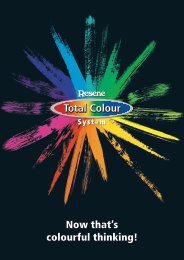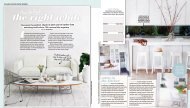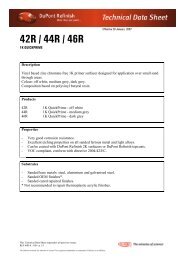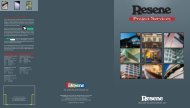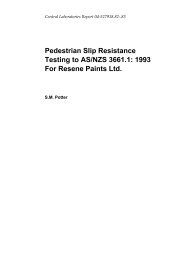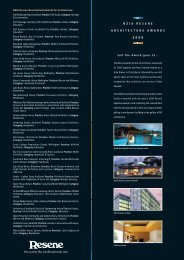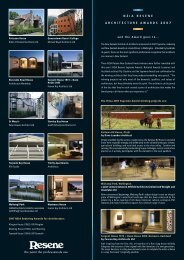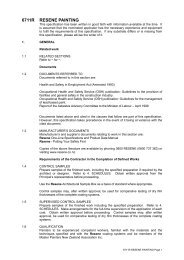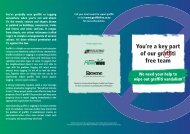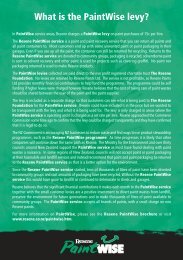Painting Exterior Timber - Resene
Painting Exterior Timber - Resene
Painting Exterior Timber - Resene
You also want an ePaper? Increase the reach of your titles
YUMPU automatically turns print PDFs into web optimized ePapers that Google loves.
Professional development<br />
programme <br />
<strong>Exterior</strong><br />
timber
<strong>Resene</strong> Professional development programme<br />
New timber and weatherboards<br />
Wash thoroughly to remove any dirt, contaminants etc.<br />
Rinse thoroughly.<br />
Primed with <strong>Resene</strong><br />
True-Prime Primer<br />
Unpainted<br />
Pre-primed with Holding<br />
or Transport Primer<br />
Prime using<br />
<strong>Resene</strong><br />
Quick Dry<br />
Primer<br />
Sand thoroughly using<br />
100-120 grit zinc stearate<br />
sandpaper refer notes<br />
Prime using<br />
<strong>Resene</strong> Wood Primer<br />
Fill any holes and gaps, lightly sand filled areas<br />
with 220 grit sandpaper and reprime with<br />
<strong>Resene</strong> Quick Dry Primer<br />
2-3 coats of <strong>Resene</strong><br />
Hi-Glo waterborne gloss<br />
2-3 coats of <strong>Resene</strong> Sonyx<br />
101 waterborne semi-gloss<br />
Also consider using <strong>Resene</strong> MoulDefender or <strong>Resene</strong> Cool Colour.
<strong>Resene</strong> Professional development programme<br />
• With the notable exception of <strong>Resene</strong> True-Prime the manufacturers of the primers used to preprime<br />
timber in NZ and Australia require that the timber is sanded and primed with an oil based<br />
primer – such as <strong>Resene</strong> Wood Primer. These pre-primers are thin, holding primers and only<br />
designed to provide temporary protection during the building process. They should not be<br />
considered part of the coating system.<br />
• Unfortunately most are so poorly bound together that<br />
unless the primer is sanded off completely an oil based<br />
primer (as opposed to a waterborne primer like <strong>Resene</strong><br />
Quick Dry) will be needed to help stabilise the pre-primer<br />
and ensure a good base for future topcoats. Most paint<br />
failures on new exterior timber are due to the poor quality<br />
of these primers.<br />
• As noted the exception is <strong>Resene</strong> True-Prime, which was<br />
developed specifically to overcome the issue identified<br />
above. It is blue in colour but unfortunately this has<br />
been copied, so the only true indicator is if the required<br />
identification sticker has been left on site.<br />
• There will always be dirt and other contaminants on timber<br />
surfaces and these must be removed before painting can<br />
commence. A thorough wash ideally with <strong>Resene</strong> Paint<br />
Prep and Housewash is recommended.<br />
• It is always best to prime any holes or cracks before filling – large filled areas may need repriming<br />
especially if <strong>Resene</strong> Sonyx 101 or <strong>Resene</strong> Hi-Glo is used.<br />
• Bargeboards inevitably have more issues than weatherboards and often deteriorate quicker due<br />
to higher U.V. exposure and differing timber qualities. To help overcome this recommend a third<br />
topcoat. Three coats are also much better over sharp edges.<br />
• We recommend either <strong>Resene</strong> Hi-Glo or <strong>Resene</strong> Sonyx 101. Apart from the gloss level there is no<br />
difference in long term performance between the two – although as a rule lower gloss paints are<br />
easier to apply so <strong>Resene</strong> Sonyx 101 has a slight application advantage.<br />
• Refer to the <strong>Resene</strong> Average rates for painting TM for the costs per square metres needed for the<br />
materials and time.<br />
• Don’t forget to add on the costs of difficult access or travelling etc<br />
you may have to allow for.<br />
• FACTORS are the time required for most painters for every square<br />
metre of work. Factor x Area gives you the hours you will use.<br />
• Do a good job for a fair price - customers like to skite about it.<br />
1800 738 383<br />
www.resene.com.au<br />
0800 RESENE (737 363)<br />
www.resene.co.nz
<strong>Resene</strong> Professional development programme<br />
<strong>Painting</strong> timber and weatherboards<br />
in good condition<br />
Treat moss and mould with<br />
<strong>Resene</strong> Moss & Mould Killer<br />
Wash and scrub using<br />
<strong>Resene</strong> Paint Prep and Housewash<br />
Sand any flaking paint using 120-150 grit<br />
zinc stearate sandpaper<br />
Spot prime using<br />
<strong>Resene</strong> Quick Dry Primer<br />
Fill any holes and gaps, lightly sand filled<br />
areas with 220 grit sandpaper and reprime<br />
with <strong>Resene</strong> Quick Dry Primer<br />
For a semi-gloss finish<br />
recommend 2 coats of<br />
<strong>Resene</strong> Sonyx 101<br />
For a high gloss finish<br />
recommend 2 coats of<br />
<strong>Resene</strong> Hi-Glo<br />
Also consider using <strong>Resene</strong> MoulDefender or <strong>Resene</strong> Cool Colour.
<strong>Resene</strong> Professional development programme<br />
• <strong>Resene</strong> Hi-Glo, <strong>Resene</strong> Sonyx 101 and <strong>Resene</strong> Lumbersider are formulated using costly adhesion<br />
promoters so they will adhere exceptionally well to aged paints, including old enamels without<br />
the need for extensive sanding of otherwise sound paints.<br />
As an indication of their adhesion properties <strong>Resene</strong> Hi-Glo and <strong>Resene</strong> Sonyx 101 can be applied<br />
directly to weathered Colorsteel®/Colorbond®.<br />
• However any loosely bound contaminants or mould on the paint surface must be removed before<br />
painting or the paint will not bond to the old surface.<br />
As exterior paint ages it will succumb to constant U.V. (ultra-violet) attack and will slowly<br />
deteriorate, with the top layer breaking down and ‘chalking’. The ‘chalk’ is mostly loosely bound<br />
pigments of TiO 2<br />
(titanium dioxide) for white paint.<br />
• ‘Chalk’ and other contaminants need to<br />
be removed (dechalking) and the most<br />
effective way is to use <strong>Resene</strong> Paint Prep and<br />
Housewash and wash and scrub the same way<br />
you would a car – scrubbing flaking areas and<br />
washing paintwork in sound condition. It is<br />
also very effective at loosening and removing<br />
salt.<br />
• Any flaking paint should be scrubbed to<br />
remove the worst affected areas (a short<br />
bristled brush or Scotchbrite pad is ideal) and<br />
sanded using 120 to 150 grit zinc stearate<br />
sandpaper ensuring the edges are feathered<br />
before spot priming using <strong>Resene</strong> Quick Dry Primer.<br />
• After sanding, prime the same day as night time dew will creep under the freshly sanded paintwork<br />
and the edges will curl and lift.<br />
• Refer to the <strong>Resene</strong> Average rates for painting TM for the costs per<br />
square metres needed for the materials and time.<br />
• Don’t forget to add on the costs of difficult access or travelling etc<br />
you may have to allow for.<br />
• FACTORS are the time required for most painters for every square<br />
metre of work. Factor x Area gives you the hours you will use.<br />
• Do a good job for a fair price - customers like to skite about it.<br />
1800 738 383<br />
www.resene.com.au<br />
0800 RESENE (737 363)<br />
www.resene.co.nz
<strong>Resene</strong> Professional development programme<br />
<strong>Painting</strong> timber and weatherboards<br />
in poor condition<br />
Treat moss and mould with <strong>Resene</strong><br />
Moss & Mould Killer<br />
Wash and scrub using <strong>Resene</strong> Paint Prep and<br />
Housewash - pay particular attention to flaking areas<br />
Remove all perished or unstable paint - see notes<br />
Sand any exposed timber and surface imperfections<br />
Spot prime using <strong>Resene</strong> Wood Primer (if rust stained<br />
and/or degraded) or <strong>Resene</strong> Quick Dry Primer<br />
<strong>Resene</strong> <strong>Timber</strong>Lock<br />
should be considered<br />
as a preservative and<br />
conditioner if paint is<br />
stripped<br />
Fill holes and gaps with Contract filler<br />
and gap filler<br />
Sand filled areas with 220 grit sandpaper and<br />
spot prime as above<br />
We recommend<br />
2-3 coats of <strong>Resene</strong> Sonyx<br />
101 waterborne semi-gloss<br />
Alternatively for very poor or rough<br />
surfaces consider <strong>Resene</strong> Lumbersider<br />
satin to disguise imperfections<br />
Also consider using <strong>Resene</strong> MoulDefender or <strong>Resene</strong> Cool Colour.
<strong>Resene</strong> Professional development programme<br />
• The paintwork will be characterised by lots of bare timber, crocodiled and flaking paint; there will<br />
likely be rusty nailheads, dirt, salt and other contaminants as well as moss and mould especially<br />
on the South side.<br />
• While waterblasting will remove paint it is likely to ‘gouge’ the timber and isn’t as effective as<br />
<strong>Resene</strong> Paint Prep and Housewash at dechalking and removing contaminants<br />
• Badly damaged and unstable paint needs to be removed. Burning off with a hot air gun is very<br />
slow, which is why most professional painters use a mechanical stripper or linbide scraper that<br />
are remarkably quick at removing poorly adhered paintwork although there is the risk of gouging<br />
the timber. It is also tedious and unpleasant work although innovative products, such as the ‘Sea<br />
to Sky’ stripping range, are proving popular as they are simple and safe to use.<br />
• <strong>Resene</strong> <strong>Timber</strong>Lock is ideal for bare timber as a surface pre-treatment and performs a similar<br />
function to Sureseal’s on old powdery surfaces. Recommend it when the customer believes paint<br />
will need to be stripped – especially on the North and North East elevations of a home.<br />
• Treat nailhead corrosion.<br />
• The paint may well contain lead, which <strong>Resene</strong> are happy to<br />
test for. If it the test is positive then take precautions including<br />
ensuring nearby soil isn’t contaminated and that lead in sanding<br />
dust isn’t ingested.<br />
• After sanding, prime the same day, as night time dew will creep<br />
under the freshly sanded paintwork and the edges will curl and<br />
lift.<br />
• The prepared surface will have repaired cracks, old paintwork<br />
and new freshly primed timber it will be less than perfect when<br />
compared to new weatherboards.<br />
Use <strong>Resene</strong> Sonyx 101 over <strong>Resene</strong> Hi-Glo, as its lower gloss will<br />
not highlight imperfections in old timber and paintwork or <strong>Resene</strong> Lumbersider if it is particularly<br />
rough.<br />
• Refer to the <strong>Resene</strong> Average rates for painting TM for the costs per square metres needed for the<br />
materials and time.<br />
• Don’t forget to add on the costs of difficult access or travelling etc<br />
you may have to allow for.<br />
• FACTORS are the time required for most painters for every square<br />
metre of work. Factor x Area gives you the hours you will use.<br />
• Do a good job for a fair price - customers like to skite about it.<br />
1800 738 383<br />
www.resene.com.au<br />
0800 RESENE (737 363)<br />
www.resene.co.nz
<strong>Resene</strong> Professional development programme<br />
Rough sawn and band sawn timber<br />
Rough sawn weatherboards<br />
New<br />
Weathered<br />
Wash<br />
thoroughly -<br />
ideally using<br />
<strong>Resene</strong> Paint<br />
Prep and<br />
Housewash<br />
<strong>Resene</strong> Moss & Mould Killer<br />
Wash using <strong>Resene</strong> Paint<br />
Prep and Housewash<br />
<strong>Resene</strong> <strong>Timber</strong>Lock if<br />
sanding is impractical<br />
<strong>Resene</strong> Wood Primer<br />
Waterblasting<br />
at low<br />
pressure can<br />
be used but is<br />
less effective<br />
and can<br />
damage timber<br />
2-3 coats of <strong>Resene</strong><br />
Lumbersider<br />
waterborne satin<br />
2 coats of <strong>Resene</strong><br />
Sonyx 101 waterborne<br />
semi-gloss<br />
Also consider using <strong>Resene</strong> MoulDefender or <strong>Resene</strong> Cool Colour.
<strong>Resene</strong> Professional development programme<br />
• It is rare to find rough sawn timber used on new homes, however it was used extensively on older<br />
homes including many historic styles. Today you are most likely to see it used for fencing, sheds<br />
and pergolas.<br />
• Unpainted rough sawn timber will use 30-40% more<br />
paint than flat sawn (or smooth) board.<br />
• Given most rough sawn is used for fencing it is probably<br />
unrealistic to expect three coats (either three of <strong>Resene</strong><br />
Lumbersider or <strong>Resene</strong> Quick Dry Primer plus two of<br />
<strong>Resene</strong> Lumbersider) to be applied. Mostly two coats of<br />
<strong>Resene</strong> Lumbersider will suffice.<br />
• Depending on the profile rolling with a long reach or<br />
180mm No. 2 (or No. 3) roller can be very effective.<br />
• Nails are usually left flush with the surface (as opposed to<br />
being punched and filled) and are simply painted over.<br />
• Old, grey and weathered rough sawn timber is not easily<br />
sanded so <strong>Resene</strong> <strong>Timber</strong>Lock should be used in lieu of<br />
sanding before applying two coats of <strong>Resene</strong> Lumbersider.<br />
• As an alternative to <strong>Resene</strong> <strong>Timber</strong>Lock and <strong>Resene</strong> Lumbersider<br />
for greyed rough sawn (or <strong>Resene</strong> Lumbersider for new timber)<br />
recommend <strong>Resene</strong> Woodsman after killing mould and washing<br />
clean.<br />
• Due to the rough profile we recommend <strong>Resene</strong> Lumbersider, which has the<br />
added benefit of being self priming, although <strong>Resene</strong> Sonyx 101 is also an option<br />
if a more cleanable surface is required – especially over old painted band sawn<br />
timber.<br />
• If repainting refer to flowcharts 2 and 3 for preparation advice.<br />
• Refer to the <strong>Resene</strong> Average rates for painting TM for the costs per<br />
square metres needed for the materials and time.<br />
• Don’t forget to add on the costs of difficult access or travelling etc you<br />
may have to allow for.<br />
• FACTORS are the time required for most painters for every square<br />
metre of work. Factor x Area gives you the hours you will use.<br />
• Do a good job for a fair price - customers like to skite about it.<br />
1800 738 383<br />
www.resene.com.au<br />
0800 RESENE (737 363)<br />
www.resene.co.nz
<strong>Resene</strong> Professional development programme<br />
Cedar weatherboards and timber<br />
Cedar<br />
Unpainted and weathered<br />
New<br />
Treat moss and mould with<br />
<strong>Resene</strong> Moss & Mould Killer<br />
Thoroughly scrub with <strong>Resene</strong><br />
Paint Prep and Housewash, a<br />
short hard-bristled scrubbing<br />
brush is ideal<br />
Ensure the surface is<br />
clean and dust free<br />
Recommend <strong>Resene</strong> <strong>Timber</strong>Lock<br />
to condition weathered Cedar<br />
before painting as it can be<br />
difficult to sand<br />
Prime using <strong>Resene</strong> Wood Primer<br />
Recommend 2 coats<br />
of <strong>Resene</strong> Sonyx 101<br />
waterborne semi-gloss<br />
For a low sheen finish recommend 2 coats of<br />
<strong>Resene</strong> Lumbersider, alternatively for a high<br />
gloss recommend 2 coats of <strong>Resene</strong> Hi-Glo<br />
Also consider using <strong>Resene</strong> MoulDefender or <strong>Resene</strong> Cool Colour.
<strong>Resene</strong> Professional development programme<br />
• Cedar is a highly resinous timber which is also<br />
why it is so durable and able to be left to weather<br />
uncoated. However the resin will bleed through<br />
waterborne primers and paints including <strong>Resene</strong><br />
Quick Dry (see photo). <strong>Resene</strong> Wood Primer is our<br />
only recommendation.<br />
• <strong>Resene</strong> Waterborne Woodsman is not affected by the<br />
resin bleed and can be applied directly onto Cedar.<br />
Conditioning with <strong>Resene</strong> <strong>Timber</strong>Lock, while a good<br />
idea before priming will not prevent the stain from leaching through <strong>Resene</strong> Quick Dry Primer.<br />
• However, surface forming wood stains should be avoided however as the top layer of Cedar<br />
degrades quickly under U.V. attack resulting in the stain flaking off. Refer to <strong>Resene</strong> Helpline if<br />
asked for a paint system to redo flaking stains on Cedar.<br />
• Redwood is part of the same family as Cedar and while it is much less common for new or recently<br />
constructed homes it presents the same issues when painted.<br />
• Cedar is a comparatively soft timber (more so than pine) and is easily damaged by waterblasting.<br />
Our only recommendation is to scrub or wash with <strong>Resene</strong> Paint Prep and Housewash.<br />
• Aged grey Cedar can be painted but should first be conditioned with <strong>Resene</strong> <strong>Timber</strong>Lock before<br />
priming and painting. Typically Cedar weatherboards are not smooth sawn and are difficult to<br />
sand and prepare. <strong>Resene</strong> <strong>Timber</strong>Lock should be viewed as an alternative to sanding where the<br />
surface or texture of the timber makes it impractical.<br />
• Flathead nails (including copper nails) are often used and left exposed rather than punched and<br />
filled and are simply primed and painted at the same time as the weatherboards.<br />
• Cedar is easily painted and is an excellent substrate for paint (more so than pine for example)<br />
once painted repainting is straightforward the only real consideration is that any bare areas need<br />
to be spot primed with <strong>Resene</strong> Wood Primer rather than <strong>Resene</strong> Quick Dry.<br />
• <strong>Resene</strong> Sonyx 101 or <strong>Resene</strong> Lumbersider suit Cedar more so than the high gloss <strong>Resene</strong> Hi-Glo<br />
due to the surface texture of the timber particularly quarter sawn boards. If repainting refer to<br />
flowcharts 2 and 3 and prime or spot prime with <strong>Resene</strong> Wood Primer.<br />
• Refer to the <strong>Resene</strong> Average rates for painting TM for the costs per<br />
square metres needed for the materials and time.<br />
• Don’t forget to add on the costs of difficult access or travelling etc you<br />
may have to allow for.<br />
• FACTORS are the time required for most painters for every square metre<br />
of work. Factor x Area gives you the hours you will use.<br />
• Do a good job for a fair price - customers like to skite about it.<br />
1800 738 383<br />
www.resene.com.au<br />
0800 RESENE (737 363)<br />
www.resene.co.nz
<strong>Resene</strong> Professional development programme<br />
Linea weatherboards<br />
Ensure the surface is clean<br />
and dust free<br />
Fill any nail holes using Contract<br />
filler and gaps with Selleys<br />
<strong>Exterior</strong> No More Gaps<br />
Spot prime filled areas with<br />
<strong>Resene</strong> Quick Dry Primer<br />
Recommend 3 coats<br />
of <strong>Resene</strong> Sonyx 101<br />
waterborne semi-gloss<br />
Alternatively recommend 3 coats<br />
<strong>Resene</strong> Lumbersider for a satin finish<br />
or 3 coats of <strong>Resene</strong> Hi-Glo for<br />
a gloss finish<br />
Also consider using <strong>Resene</strong> MoulDefender or <strong>Resene</strong> Cool Colour.
<strong>Resene</strong> Professional development programme<br />
• <strong>Resene</strong> Sonyx 101 is our recommended topcoat for Linea. As there are often imperfections in the<br />
boards that <strong>Resene</strong> Hi-Glo will highlight. <strong>Resene</strong> Lumbersider is an option especially if the boards<br />
are in poor condition with lots of filled nailheads, joins etc or if a more rustic look is preferred.<br />
• Linea weatherboards utilise innovative ceramic technology to produce a very durable, movement<br />
and moisture resistant substrate – and is an ideal substrate for painting as it overcomes many of<br />
the movement related issues inherent in timber.<br />
• Its lack of movement and inertness mean that strong colours can be used without the risk of<br />
warping and shrinkage – problems common to timber weatherboards. As a result it is proving<br />
popular with designers and architects wishing to use stronger colours on their designs.<br />
• While they arrive at a building site primed they will need spot priming for any nail holes, cut edges<br />
and any sanded areas.<br />
• For maximum durability we recommend three topcoats are applied. This is also a condition of<br />
the Linea warranty, mainly because the additional coat increases the coverage and therefore<br />
durability over sharper edged profiles.<br />
• To extend colour durability still further a coat of <strong>Resene</strong> Multishield+ (flat, satin or gloss) can be<br />
applied (usually over <strong>Resene</strong> Lumbersider).<br />
• Repainting older fibre cement weatherboards such as Hardiplank and Weathersider is usually<br />
straightforward. Our recommended topcoat is <strong>Resene</strong> Lumbersider.<br />
• Refer to the <strong>Resene</strong> Average rates for painting TM for the costs per<br />
square metres needed for the materials and time.<br />
• Don’t forget to add on the costs of difficult access or travelling etc<br />
you may have to allow for.<br />
• FACTORS are the time required for most painters for every square<br />
metre of work. Factor x Area gives you the hours you will use.<br />
• Do a good job for a fair price - customers like to skite about it.<br />
1800 738 383<br />
www.resene.com.au<br />
0800 RESENE (737 363)<br />
www.resene.co.nz
<strong>Resene</strong> Professional development programme<br />
Shadowclad and plywood<br />
Ensure the surface is clean<br />
and dust free<br />
Prime using <strong>Resene</strong> Quick Dry<br />
Primer<br />
Fill any nail holes and gaps, spot<br />
prime with <strong>Resene</strong> Quick Dry Primer<br />
Use <strong>Resene</strong><br />
<strong>Timber</strong>Lock<br />
for weathered<br />
grey plywood/<br />
Shadowclad<br />
Recommend 2 coats of <strong>Resene</strong><br />
Lumbersider followed by a third coat<br />
after 4-6 months to fill checks and<br />
splits, refer notes<br />
Alternatively for a semi gloss finish<br />
recommend 2 coats of <strong>Resene</strong> Sonyx<br />
101 semi gloss followed by a third<br />
coat after 4-6 months to fill checks<br />
and splits, refer notes<br />
‘Use paint colours with a light reflectance value of 40-100% to meet the 50 year<br />
durability requirement of the NZBC to prevent potential problems such as face<br />
checking. The use of ‘Cool Colour Technology’ can increase the range of dark colours<br />
(LRV
<strong>Resene</strong> Professional development programme<br />
• Shadowclad is a form of plywood and behaves in a similar manner. It is manufactured by Carter<br />
Holt in Australasia. Most commonly it is designed to look like rough sawn vertical timber – it is<br />
promoted as being suitable as a bracing board as well as cladding. Typically flathead galvanised<br />
nails are used to fix the sheets and are simply painted over.<br />
• Bracing refers to how a structure is stabilised against movement in strong winds and<br />
earthquakes.<br />
• To comply with the NZ Building Code Shadowclad must be painted or stained and not left to<br />
weather. Marine ply can however.<br />
• It readily accepts paints and stains although due to an anomaly in the NZ Building Code when<br />
it is stained (with <strong>Resene</strong> Woodsman for example). It doesn’t meet the bracing standards and<br />
additional bracing (and cost) is needed.<br />
• Previously painted plywood and Shadowclad should be prepared and painted the same as timber<br />
weatherboards (refer to flowcharts 2 and 3).<br />
• The most common form of plywood used exterior is Marine ply. Construction plywood is also<br />
frequently used but typically as a base for a cladding such as vertical Cedar boards and polystyrene<br />
- usually to improve bracing.<br />
• Plywood and Shadowclad are manufactured from alternating thin<br />
layers of layered timber that are then glued together. The top layer<br />
is likely to split or check when first exposed to moisture and heat.<br />
(a rainy day followed by a sunny day!) – This will happen regardless<br />
of whether it is painted or stained first and is not a board fault.<br />
• We recommend that either it is deliberately wet and allowed to<br />
check (allow approx. 24 hours) and then primed and painted -<br />
applying a third coat to the checked area or painting it straight<br />
away and allowing for a third coat to be applied at a later date once it has checked.<br />
• The very best but hardly used paint system for ply is <strong>Resene</strong> X-200 for its crack filling and high<br />
build properties.<br />
• A roller is an ideal way to paint plywood and the face of Shadowclad.<br />
• The statement on the preceeding page is from the <strong>Resene</strong> specification system for Shadowclad<br />
and is included as a note to point out the requirement for light reflectance<br />
values over 40% unless <strong>Resene</strong> Cool Colours are used and the local<br />
council accepts the change.<br />
• Refer to the <strong>Resene</strong> Average rates for painting TM for the costs per square<br />
metres needed for the materials and time.<br />
• Don’t forget to add on the costs of difficult access or travelling etc you<br />
may have to allow for.<br />
• FACTORS are the time required for most painters for every square metre of<br />
work. Factor x Area gives you the hours you will use.<br />
• Do a good job for a fair price - customers like to skite about it.<br />
1800 738 383<br />
www.resene.com.au<br />
0800 RESENE (737 363)<br />
www.resene.co.nz
<strong>Resene</strong> Professional development programme<br />
New wooden windows, doors and joinery<br />
Thoroughly wash - ideally with <strong>Resene</strong><br />
Paint Prep and Housewash, rinse well<br />
Unprimed bare timber<br />
Pre-primed with Holding or<br />
Transport primer, refer notes<br />
Lightly sand to remove<br />
any surface imperfections<br />
or greyed timber and<br />
prime using <strong>Resene</strong> Quick<br />
Dry Primer<br />
Thorougly sand using 100-120<br />
grit zinc stearate sandpaper,<br />
refer notes<br />
Prime using <strong>Resene</strong> Wood Primer<br />
Fill any nail holes and cracks with Contract Filler,<br />
sand smooth and spot prime<br />
Apply 2 coats of <strong>Resene</strong><br />
Lustacryl semi-gloss<br />
waterborne enamel<br />
Apply 2 coats of <strong>Resene</strong><br />
Enamacryl gloss<br />
waterborne enamel<br />
Also consider using <strong>Resene</strong> MoulDefender or <strong>Resene</strong> Cool Colour.
<strong>Resene</strong> Professional development programme<br />
• Most new windows come pre-primed and are coated in the same pre-primers as weatherboards.<br />
Unfortunately the same quality issues also arise.<br />
• If windows are puttied (as opposed to using a timber bead) wait until it is firm to touch before<br />
proceeding to the painting stage – usually after 10 days, unless a synthetic fast drying putty has<br />
been used.<br />
• It is important to paint the top, bottom and inside edges of the window to ensure a good moisture<br />
seal and help reduce swelling. We strongly recommend the full three coat system is<br />
applied to these areas.<br />
• Traditional full gloss solventborne enamels used to be<br />
our only recommendation for exterior joinery however<br />
because of the significant increase in U.V. resistance<br />
that the waterborne enamels have and their ease of<br />
application they are now preferred.<br />
• If a customer wants to use full gloss solventborne<br />
enamel then that is fine. Simply advise them that we<br />
would expect the waterborne equivalent to perform<br />
better outside and follow the system guide.<br />
• While the basis of some debate we recommend that<br />
windows are completed before the weatherboards and<br />
that the edges or scribers are (see photo) painted the<br />
same colour as the window frames rather than the<br />
weatherboard colour if different.<br />
• Refer to the <strong>Resene</strong> Average rates for painting TM for the<br />
costs per square metres needed for the materials and<br />
time.<br />
• Don’t forget to add on the costs of difficult access or travelling etc<br />
you may have to allow for.<br />
• FACTORS are the time required for most painters for every square<br />
metre of work. Factor x Area gives you the hours you will use.<br />
• Do a good job for a fair price - customers like to skite about it.<br />
1800 738 383<br />
www.resene.com.au<br />
0800 RESENE (737 363)<br />
www.resene.co.nz
<strong>Resene</strong> Professional development programme<br />
Repainting wooden windows,<br />
doors and joinery<br />
Treat moss and mould using<br />
<strong>Resene</strong> Moss & Mould Killer<br />
Thoroughly wash and scrub using<br />
<strong>Resene</strong> Paint Prep and Housewash,<br />
a Scotchbrite pad is ideal<br />
Sand any flaking paint and inside<br />
facings of the window and frame<br />
Spot prime using <strong>Resene</strong> Quick<br />
Dry Primer or <strong>Resene</strong> Wood Primer<br />
Replace any putty using Red Devil<br />
synthetic putty, fill any nail holes<br />
etc, spot prime putty using <strong>Resene</strong><br />
Wood Primer after allowing 24<br />
hours to cure<br />
Remove or strip any<br />
perished or unstable<br />
paint - typically the<br />
windowsill<br />
Condition stripped<br />
areas with <strong>Resene</strong><br />
<strong>Timber</strong>Lock<br />
We recommend 2 coats of <strong>Resene</strong><br />
Lustacryl semi-gloss waterborne<br />
enamel<br />
Alternatively for high gloss finish<br />
recommend 2 coats of <strong>Resene</strong><br />
Enamacryl gloss waterborne enamel<br />
Also consider using <strong>Resene</strong> MoulDefender or <strong>Resene</strong> Cool Colour.
<strong>Resene</strong> Professional development programme<br />
• The best way to wash and prepare windows is to use <strong>Resene</strong><br />
Paint Prep and Housewash and a 3M scourer or Scotchbrite<br />
pad which is effective at reaching edges and recesses of<br />
windows.<br />
• Although not always done, the top, internal and bottom faces<br />
of the window should be painted.<br />
• Hack out and replace putty that has dried out and come<br />
loose – we recommend Red Devil or Bostik Synthetic putty<br />
as they can be primed within 24 hours with <strong>Resene</strong><br />
Wood Primer and then painted with <strong>Resene</strong> Lustacryl<br />
or <strong>Resene</strong> Enamacryl (traditional putty needs to cure<br />
for two weeks!)<br />
• The inside faces will need sanding to ‘de gloss’ them.<br />
Old enamel paint not exposed to U.V. light (the inside<br />
faces of windows and frames in particular) gets harder<br />
and more brittle over time and will need thorough<br />
sanding before painting. The exposed faces will need<br />
washing to ‘dechalk’ if the paintwork is sound.<br />
• Substrates that are exposed at a 45 degree angle to the sun are<br />
subject to twice the level of U.V. attack that a vertical or horizontal<br />
surface will. In the same way that our nose will get sun burnt more<br />
quickly that our cheeks. This is why the top edge of a windowsill will<br />
deteriorate more quickly than other painted surfaces.<br />
• We recommend <strong>Resene</strong> Lustacryl as its lower gloss conceals<br />
imperfections more effectively than the higher gloss <strong>Resene</strong><br />
Enamacryl.<br />
• Refer to the <strong>Resene</strong> Average rates for painting TM for the costs per<br />
square metres needed for the materials and time.<br />
• Don’t forget to add on the costs of difficult access or travelling etc you<br />
may have to allow for.<br />
• FACTORS are the time required for most painters for every square metre<br />
of work. Factor x Area gives you the hours you will use.<br />
• Do a good job for a fair price - customers like to skite about it.<br />
1800 738 383<br />
www.resene.com.au<br />
0800 RESENE (737 363)<br />
www.resene.co.nz
<strong>Resene</strong> Professional development programme<br />
High gloss feature doors and joinery<br />
Feature joinery<br />
Previously painted<br />
Treat for moss and<br />
mould and wash as<br />
per flowchart 9<br />
New<br />
Prime using<br />
<strong>Resene</strong> Quick<br />
Dry Primer<br />
Refer to<br />
flowchart 1<br />
if pre-primed<br />
and flowchat<br />
5 if Cedar<br />
Good<br />
condition<br />
Lightly sand<br />
using 220<br />
grit zinc<br />
stearate<br />
sandpaper to<br />
‘degloss’ the<br />
surface<br />
Poor<br />
condition<br />
Scrape and sand<br />
to remove poorly<br />
adherring paint,<br />
consider a full strip and<br />
<strong>Resene</strong> <strong>Timber</strong>Lock<br />
Spot prime any bare<br />
timber and sharp<br />
edges using <strong>Resene</strong><br />
Quick Dry Primer<br />
Fill any holes and<br />
gaps using Contract<br />
Filler, sand smooth and<br />
reprime as above<br />
Apply <strong>Resene</strong> Acrylic<br />
Undercoat matched to<br />
the topcoat colour<br />
Lightly sand using<br />
220 grit zinc stearate<br />
sandpaper to remove<br />
any imperfections<br />
Apply 2 coats of <strong>Resene</strong> Super Gloss Enamel,<br />
lightly sanding with 220 grit between coats
<strong>Resene</strong> Professional development programme<br />
• <strong>Resene</strong> Super Gloss Enamel dries to a higher gloss and has slightly better flow than <strong>Resene</strong><br />
Enamacryl and as a result has a smoother higher gloss finish. Many people prefer this look for<br />
feature elements of their home such as a feature front door.<br />
• However <strong>Resene</strong> Super Gloss (and all solventborne enamels) weathers and degrades more quickly<br />
than <strong>Resene</strong> Enamacryl, and will need to be redone sooner as a result – although as many front<br />
doors are relatively sheltered and set back from direct sunlight this can be less of an issue.<br />
• For the ‘very best gloss finish’ apply two coats of <strong>Resene</strong> Super Gloss over either <strong>Resene</strong> Quick<br />
Dry Primer or <strong>Resene</strong> Acrylic Undercoat in a colour matched to the <strong>Resene</strong> Super Gloss colour and<br />
lightly sand with 220 grit sandpaper to achieve a smooth surface before applying the final coat.<br />
• <strong>Resene</strong> Quick Dry Primer and <strong>Resene</strong> Acrylic Undercoat have excellent sanding properties making<br />
them ideal as a base for high gloss finishes<br />
• <strong>Resene</strong> Acrylic Undercoat can be tinted to most colours in the Total Colour System and is an ideal<br />
base for strong colours. However it is not suitable as a primer for bare timber as it doesn’t have<br />
the anti fungal and timber preserving properties that <strong>Resene</strong> Quick Dry Primer has.<br />
• Refer to the <strong>Resene</strong> Average rates for painting TM for the costs per<br />
square metres needed for the materials and time.<br />
• Don’t forget to add on the costs of difficult access or travelling etc you<br />
may have to allow for.<br />
• FACTORS are the time required for most painters for every square<br />
metre of work. Factor x Area gives you the hours you will use.<br />
• Do a good job for a fair price - customers like to skite about it.<br />
1800 738 383<br />
www.resene.com.au<br />
0800 RESENE (737 363)<br />
www.resene.co.nz
<strong>Resene</strong> Professional development programme<br />
Preparation products, primers, topcoats
<strong>Resene</strong> Professional development programme<br />
Preparation products, primers, topcoats<br />
1800 738 383<br />
www.resene.com.au<br />
0800 RESENE (737 363)<br />
www.resene.co.nz
In Australia:<br />
PO Box 785, Ashmore City, Queensland 4214<br />
Call 1800 738 383, visit www.resene.com.au<br />
or email us at advice@resene.com.au<br />
In New Zealand:<br />
Vogel Street, PO Box 38242, Wgtn Mail Centre, Lower Hutt 5045<br />
Call 0800 RESENE (737 363), visit www.resene.co.nz<br />
or email us at advice@resene.co.nz<br />
© Copyright <strong>Resene</strong> Paints Ltd, December 2007.<br />
Printed on environmentally responsible paper, which complies with the requirements of<br />
environmental management systems EMAS and ISO14001, using vegetable inks. Please recycle.



